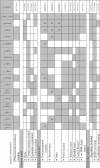Patterns of bone mineral density testing: current guidelines, testing rates, and interventions
- PMID: 15209594
- PMCID: PMC1492483
- DOI: 10.1111/j.1525-1497.2004.30240.x
Patterns of bone mineral density testing: current guidelines, testing rates, and interventions
Abstract
Objectives: To identify potential obstacles to bone mineral density (BMD) testing, we performed a structured review of current osteoporosis screening guidelines, studies of BMD testing patterns, and interventions to increase BMD testing.
Design: We searched medline and HealthSTAR from 1992 through 2002 using appropriate search terms. Two authors examined all retrieved articles, and relevant studies were reviewed with a structured data abstraction form.
Measurements and main results: A total of 235 articles were identified, and 51 met criteria for review: 24 practice guidelines, 22 studies of screening patterns, and 5 interventions designed to increase BMD rates. Of the practice guidelines, almost one half (47%) lacked a formal description of how they were developed, and recommendations for populations to screen varied widely. Screening frequencies among at-risk patients were low, ranging from 1% to 47%. Only eight studies assessed factors associated with BMD testing. Female patient gender, glucocorticoid dose, and rheumatologist care were positively associated with BMD testing; female physicians, rheumatologists, and physicians caring for more postmenopausal patients were more likely to test patients. Five articles described interventions to increase BMD testing rates, but only two tested for statistical significance and no firm conclusions can be drawn.
Conclusions: This systematic review identified several possible contributors to suboptimal BMD testing rates. Osteoporosis screening guidelines lack uniformity in their development and content. While some patient and physician characteristics were found to be associated with BMD testing, few articles carefully assessed correlates of testing. Almost no interventions to improve BMD testing to screen for osteoporosis have been rigorously evaluated.
Figures

Comment in
-
The continuing evolution of women's health.J Gen Intern Med. 2004 Jul;19(7):810-1. doi: 10.1111/j.1525-1497.2004.40403.x. J Gen Intern Med. 2004. PMID: 15209598 Free PMC article. No abstract available.
References
-
- Woodhouse A, Black DM. BMD at various sites for the prediction of hip fracture: a meta-analysis. J Bone Miner Res. 2002;15:S145.
-
- Cummings SR, Black DM, Nevitt MC, et al. Bone density at various sites for prediction of hip fractures. Lancet. 1993;341:72–5. - PubMed
-
- Centers for Disease Control and Prevention. Healthy People 2010. Available at: http://www.health.gov/healthypeople/, volume1/02Arthritis.htm#_Toc49053811. Accessed April 30, 2004.
-
- Consensus Development Panel. National Institutes of Health Consensus Development Conference Statement: Osteoporosis Prevention, Diagnosis, and Therapy. Rockville, Md: National Institutes of Health; 2000. p. 27.
Publication types
MeSH terms
Grants and funding
LinkOut - more resources
Full Text Sources
Medical
Miscellaneous
